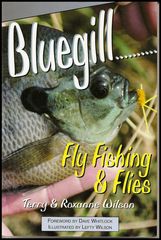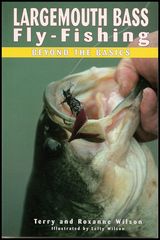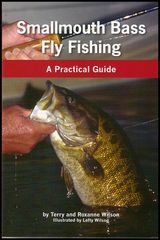Featured Fly Tiers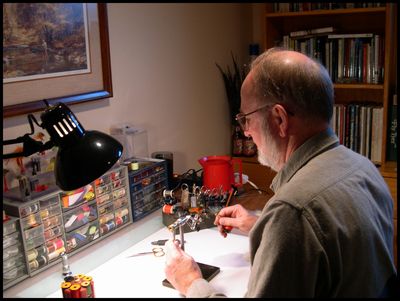
The fly tyers featured on this page have achieved prominance in the fly tying game. They have distinguished themselves by demonstrating their fly tying skills at fly fishing conclaves and shows and by providing seminars, workshops, and tying classes for fly fishing clubs and other organizations. Some have written articles for major fly fishing magazines, published books, videos, and DVD's on fly fishing and fly tying, and are editors of web sites devoted to fly fishing and fly tying.
John Peterie ties the Calcasieu Pig Boat
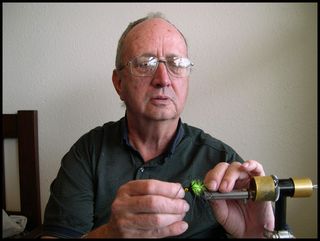 John hails from Plano, Texas. He is a long standing member of the Dallas Flyfishers and a charter member of the club's "Roadkill Rountable," a small group of expert flytiers who give weekly tying demonstrations at outdoor stores and fly shops throughout the Dallas area. John is also a member of the Whiting Farms Pro Team. John has been a guest fly tyer at a number of fly fishing shows and conclaves including the Federation of Fly Fishers Southern Council Conclave, the Southeastern Council Conclave, the Huston Fly Fishing Show, the Sowbug Roundup, the Smallmouth Rendezvous, and the Federation of Fly Fishers International Conclave in Montana. 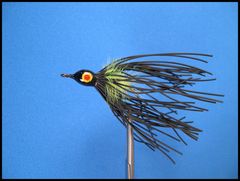 The Calcasieu Pig Boat is one of many warmwater flies made famous by the late Tom Nixon in his book "Fly Tying and Fly Fishing for Bass and Panfish." The first edition was published in 1968 and a revised third edition was published in 1999, just a few years before his death. Join John as he takes you step-by-step through the process of tying the famous Calcasieu Pig Boat.
Fred DuPre' ties "Fred's Frog"
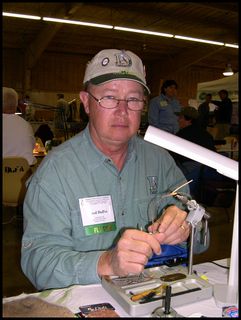 Fred DuPre' lives in Colleyville, Texas. Fred has been tying flies for more than forty years. He is a Director with Verizon and has fished all 50 states, the 10 Canadian Provences, and 6 foreign countries. Fred is a member of the Dallas Flyfishers, Fort Worth Flyfishers, North Santiam Spey Casters, Roadkill Roundtable, Federation of Fly Fishers, Trout Unlimited, and the International Flytiers Guild. 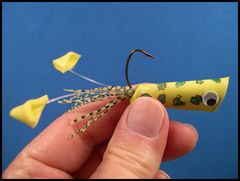 Fred has tied flies at numerous fly tying events including The Sowbug Roundup, the Southern Council FFF Annual Conclave, the Houston Show, Flyfish Texas, and the Smallmouth Rendevouz. "Fred's Frog" is one of his latest creations. It is designed as a big bass fly that rides hook point up. Join Fred as he takes you step-by-step through the tying process for this intriguing top water lure.
Anthony Hipps ties Hipps's Soft-Bodied Popper and HellCraw
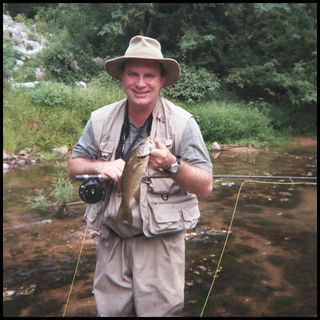 Anthony Hipps is a professional fly tying artist, instructor, and speaker who hails from Lexington, North Carolina. He has been tying flies for more than twenty years, specializing in deer hair bass flies, smallmouth bass nymphs, saltwater streamers, and soft-bodied foam poppers. In 2004 he was a featured tier of bonefish flies on the Outdoor Life Network's "Fly Fish TV Magazine." Anthony's current project is fleshing out the manuscript for a book on tying warmwater flies that will be published by the Lyon's Press. Anthony is also active with the Federation of Fly Fishers Southeastern Council, serving on the Board of Directors and as the Council's Fly Tying Chairman for the past several years. He enjoys fishing for smallmouth bass as well as other warmwater species. Two of his favorite "smallie" lures are the Soft-Bodied Popper and the HellCraw. A feature article describing the Soft-Bodied popper appeared in the Summer 2006 issue of Fly Tyer Magazine. A feature article describing the HellCraw appeared in the Spring 2007 issue. Join Anthony as he takes you step-by-step in the process of tying Hipps's Soft-Foam Popper and Hipps's HellCraw. 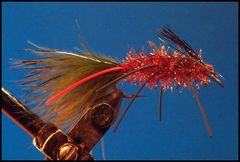 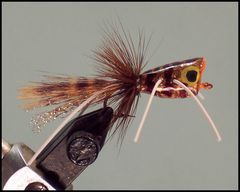
Bill Heugel Ties the Spooky Shad
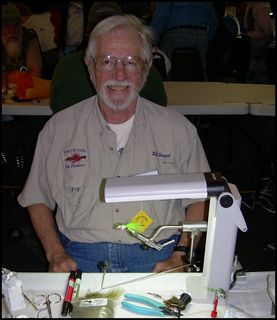 Bill Heugel lives on the shores of Toledo Bend Lake near Hemphill, Texas, where he spends much of his time tying flies and fishing for largemouth bass. Bill is an active member of the Piney Woods Flyfishers and has held the position of Secretary/Treasurer for the club. Like fellow Texans Billy Munn, Jeff Mack, and Jimmy Nix, Bill is an excellant tier of deer hair bugs and divers, which is his preferred tying specialty. As is the case with many other versitile fly tiers, Bill is adept at tying a variety of fly styles, as you will see in the tying sequence for his Spooky Shad. 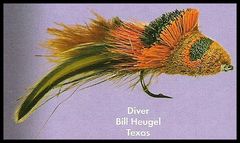 This Deer Hair Diver, which appeared in the Federation of Fly Fishers "Flyfisher Magazine," is an excellant example Bill's deer hair work. Over the years Bill has been a guest fly tier at many flyfishing shows and conclaves including the Texas Fly Fishing Show, the Sow Bug Roundup, the Smallmouth Rendezvous, the Federation of Fly Fishers Southeastern Council Conclave, and the Federation of Fly Fishers Southern Council Conclave. Bill currently is the Fly Tying Chairman for the Federation of Fly Fishers Gulf Coast Exposition which will be held for the first time at the Lake Charles Civic Center on May 18, 19, and 20, 2007, in Lake Charles, Louisinia. In the tying sequence that follows, Bill ties the Spooky Shad utilizing some of the tying techniques incorporated in Anthony Hipps Soft-Foam Popper. Join Bill as he takes you step-by-step through the tying process as he ties the Spooky Shad. 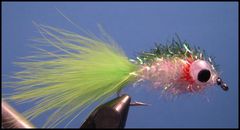 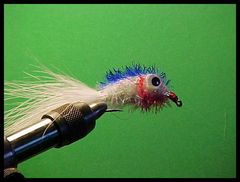
Mike George's Deer Hair Sculptures
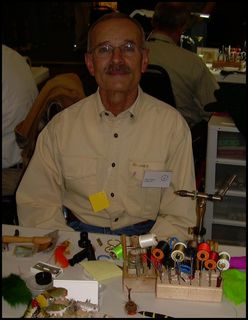 Deer hair is one of the most versitile fly tying materials to be found on the fly tiers bench. For more than half a century, ever since Dr. James Henshall created the first hair bug, commonly referred to as the Henshall Bug, innovative fly tiers have used deer body hair and bucktail hair to create a variety of poppers, divers, sliders, streamers, and wet flies. Deer hair can be spun, stacked, flared, folded, or blended to form fly bodies, heads, collars, skirts, and backs. It is also used to form wings, tails, and legs on various fly patterns. Deer Hair, when it is spun or stacked on an appropriate hook, really comes into it's own when it is applied to various types of deer hair bugs, divers, and sliders. Today, the most common flies that are made from spun or stacked deer hair are the "Most Whit Hair Bug" created by Dave Whitlock, the "Dahlberg Diver" created by Larry Dahlberg, and "Tap's Bug" created by H.G. (Tap) Tapply. Nowadays, most fly tiers who enjoy working with deer hair tie those deer hair bugs or variations of them. As you will see on the following pages, Mike George, a native Iowan now living in Kansas has taken the art of spinning and stacking deer hair to the highest level with his exquisite deer hair creations. In my humble opinion, Mike is one of the best deer hair sculpturers in the country. 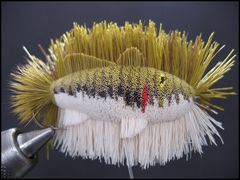
Half-Trimmed Bass Fly tiers who spin and stack deer hair have their own special techniques to form well made deer hair heads and bodies. Mike's special techniques allows him to build a body that is so tight that, once it's properly trimmed, it could be sanded with sand paper. Once Mike has filled a hook with deer hair it appears to be nothing more than a big hair ball. But then the magic begins as Mike, with the help of scissors and a double-edged razor blade, transforms the ball of hair into a beautiful sculpture of a fish or other creature. 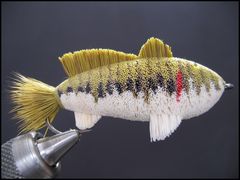
Completely Trimmed Bass His sculptures are composed of different colors of deer hair, sometimes in combination with other common fly tying materials such as rabbit strips, chicken feathers, rubber legs, Marabou, and Krystal Flash. The vivid colors in Mike's sculptures are the result of the colors of the materials used, not the result of paint or color markers. Mike has tied at various venues including the Bass Pro Shop in Springfield, Missouri, the Sow Bug Roundup, the Federation of Fly Fishers Southern Council Conclave, the Houston Fly Tying Festival, the Smallmouth Rendezvous, and the Federation of Fly Fishers International Conclave in Montana. His fly sculptures are regularly auctioned at Federation of Fly Fishing Conclaves in FFF Fly Plates. Photos and descriptions of his works often appear in the federation's "Flyfisher" Magazinie. A feature article by Mike appeared in the Fall 2003 issue of Fly Tyer Magazine and some of his work was included in the Fall 2004 issue. Mike was the winner of the "Patent Patterns" section of the summer 2005 issue of Fly Fishing and Tying Journal. One of his fly sculptures was also featured in an ad campaign conducted by the First National Bank of Olathe, Kansas. Most recently, photos of Mike's fish scuptures appeared in the Art of Angling Journal. In 2004 Mike conducted an Advanced Deer Hair Tying Seminar at the Southern Council Conclave In Mountain Home, Arkansas and was honored as the FFF Southern Council "Fly Tyer of the Year". Mike's other honors include First and Second place medals in the 2006 Federation of Fly Fishers Fly Tying Competition and First Place in the Open Catagory of the 2004, 2005, 2006, and 2007 Mustad Scandinavian Open Fly Tying Competition. Visit the following pages to view Mike George's exceptional Deer Hair Sculptures.
Lance Zook ties Zook's Foam Minnow
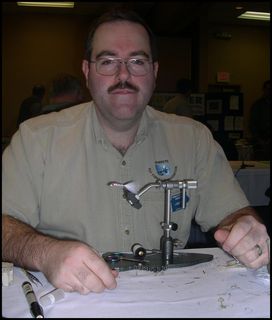 Lance Zook, who hails from Cedar Rapids, Iowa, has been tying and fishing the Foam Minnow since the early 90's and has caught a variety of warmwater gamefish with it. On one of his best days on the Maquoketa River in Northeast Iowa, Lance and a fishing companion caught well over a hundred smallmouth bass on the Foam Minnow on an all-day float of the catch and release portion of the river. Lance is an active member of the Hawkeye Fly Fishing Association, a state-wide organization with over four-hundred members throughout the state. Over the years he has held virtually every office in the association and has been actively involved in organizing and coordinating association events. Lance and association member Jeff Moore are currently editing a second edition of "Fly Patterns of the Midwest" a Hawkeye Fly Fishing Association book with a hundred favorite fly patterns submitted by club members. The association sponsors several weekend events throughout the year including the Annual Meeting and Fly Fishing Show in the winter, the Bluegill Outing on a Southern Iowa lake in the spring, the Smallmouth Outing on Northeast Iowa Rivers in the summer, and the Trout Outing on Northeast Iowa spring creeks in the fall. In addition, the association conducts several stream improvement days throughout the year in cooperation with the Iowa Department of Natural Resources. 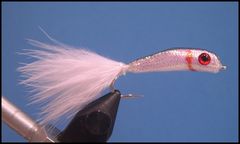 For several years Lance wrote a fly tying column for the association's bi-monthly magazine, "The Flyline." Each issue featured one of Lance's creations along with step-by-step tying instructions. Many of the flies were designed to take warmwater gamefish and the "Foam Minnow" along with a companion fly, the "Foam Popper," were among those creations. Lance ties the Foam Minnow with a shad finish shown in the tying sequence and also in a perch finish which will be described in the "Tying Notes" section of the pages that follow. Join Lance as he takes you step-by-step through the tying process as he ties the "Zook's Foam Minnow."
Max Birnkammer ties the Stillwater Bluegill Streamer
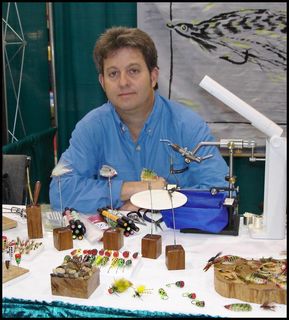 Warmwater angler and fly tyer Max Birnkammer lives in Smyrna, Georgia, a suburb of Atlanta. Max started tying flies five years ago. He favors tying and hand painting warmwater poppers and streamers which he uses to catch largemouth, kentucky spotted, and shoal bass in the rivers and lakes close to his home. Max recently published his first fly tying article, "Bass Bug Paint Shop" in the spring 2007 issue of Fly Tyer magazine. If you're not a subscriber to Fly Tyer, you should be. For more information about the magazine go to the "Tier Resources Page" and check out the fly fishing and tying magazine section. 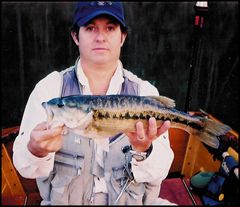 In addition to tying flies and writing magazine articles, Max builds his own fly rods and can often be seen fishing from one of his vintage wooden boats. He also catches some great looking fish out of those boats as evidenced by the photo at the right. Each summer Max makes his way to Maine to fish for northern smallmouuth bass which he believes to be the ultimate trophy in warmwater fly fishing. I would agree with Max. Max has been a demonstration tier at fly shops and fly fishing shows including the Federation of Fly Fishers Southeastern Council Conclave held at Georgia's Callaway Gardens; a mecca for those who like to fish for big bluegills and bass. He also custom ties flies, provides individual and group fly tying instruction, operates a warmwater guide service in northwest Georgia, and sells a variety of custom made fly tying tools. To learn more, check out his web site at Stillwaterangler.com. 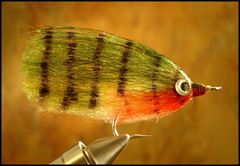 Max has developed an interesting and unique set of streamers that have proven to be effective for a variety of gamefish. There are four color patterns in the set; the Stillwater Bluegill, the Stillwater Perch, the Stillwater Shad, and the Stillwater Trout. Each color pattern employs the same tying procedures. The only difference between the patterns are the colors of their markings. Join Max as he takes you step-by-step through the tying process as he ties the "Stillwater Bluegill Streamer."
Terry Wilson ties Wilson's Bass Bully
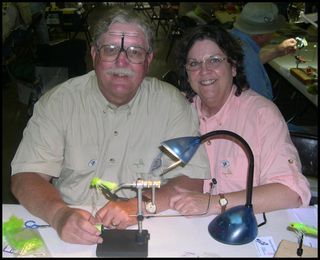 Terry and Roxanne Wilson live in southwest Missouri, where they enjoy fishing the streams and lakes in the Ozark Mountains. The Wilsons have presented innovative, practical fly-fishing methods for bass, bluegill, crappie, gar, and channel catfish for more than twenty years in over a hundred magazine articles published in Fly-fishing and Tying Journal, The Flyfisher, Midwest Fly-Fishing, Warmwater Fly-Fishing, Fly-Fishing Quarterly, BassMaster Magazine, Ontario Out of Doors, and many others. They are also staff writers for St. Louis based Outdoor Guide Magazine. Terry and Roxanne are members of the Missouri Smallmouth Alliance and are active life members of the Federation of Fly Fishers. They were presented with the Federation's Don Harger Memorial award in 1996 for their contributions to the sport of fly fishing. Roxanne was named 1994 Woman of the Year by the Federation's Southern Council. They are also members of the Federation's Warmwater Conservation Committee. Terry's original flies for bluegills, largemouth bass, and smallmouth bass have been featured in Fly Fish America, Fly-Fishing and Tying Journal, and the Federation of Fly Fishers Magazine. One of his best known bluegill flies, "Bully's Bluegill Spider," has become the fly of choice for many warmwater anglers across the country. Bully's Bluegill Spider can be tied in a number of different colors depending upon which color the bluegills in your favorite pond prefer. 
His warmwater fly patterns, along with "Bully's Bluegill Spider" have also appeared in a number of fly fishing and fly tying books including "Innovative Flies and Techniques" published in 2005 and the Federation of Fly Fishers "Fly Pattern Encyclopedia" published in 2000.
Roxanne is the photographer for the team and her excellent photography appears in all of their magazine articles and slide show presentations. All three of the Wilson's books include her photographs of some of their greatest fly fishing moments in pursuit of warmwater gamefish. Their first book, "Bluegill Fly-Fishing and Flies," was published by Frank Amato Publications in April, 1999. "Largemouth Bass Fly-Fishing: Beyond the Basics," was published in 2001. Their latest book, "Smallmouth Bass Fly-Fishing: A Practical Guide," was published in early 2007.
The books are lavishly illustrated with drawings and color photographs. Chapters are devoted to a discussion of where the fish live, successful presentation strategies under various fishing conditions, and fly pattern photos, recipes, and tying instructions for the best flies to do the job. If you want to order any of their books, you can contact them their new web site, The Bluegill Pond. The Bluegill Pond is packed with fishing techniques and other information for those of us who enjoy fishing for all warmwater gamefish. In addition, you can find information about how to bring them to your club for presentations and demonstrations, or order their books and custom tied flies. 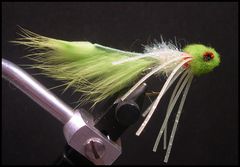 Terry, Roxanne, and I were among a group of fly tiers at the 2007 Smallmoth Rendezveou in Tahlaquah, Oklahoma, where they gave an excellent seminar on smallmouth fly fishing. It was at this meeting that I was able to photograph Terry as he tied one of his favorite black bass lures. He calls his creation "Wilson's Bass Bully". I can't wait to try it out on my favorite smallmouth streams in northeast Iowa. Wilson's Bass Bully is a fairly easy fly to tie. One of it's unique features is a wool head which completely surrounds the lead barbell eyes. The other components include a short piece of Zonker strip for the tail, Estaz for the body, a piece of red chenille for the gills, and a bunch of sili-legs. All of these materials are lashed to a TMC 8089 hook. Join Terry as he takes you step-by-step through the tying process as he ties Wilson's Bass Bully.
A Tribute to Joe Messinger and his Bucktail Frog
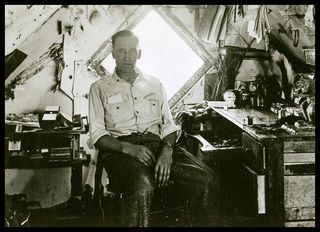 Virtually every fly tyer who ties deer hair bass bugs knows about Joe Messinger. His Bucktail Frog has probably received more acclaim over the years than any other deer hair lure ever created. Joe Messinger, shown here at his tying bench around 1935, passed on in 1966 at the age of seventy-four. Forty Years later a Messinger Bucktail Frog , tied by his son Joe Jr., mounted in a shadow box along with his dad's photo and a signature card, can bring six hundred dollars or more at auction at Fly Fishig Conclaves. That says a lot about Joe Messinger's legacy. I have several books on bass fishing and tying bass flies in my library. Most of them mention the Messinger Bucktail Frog and it's role in the evolution of bass bug design. 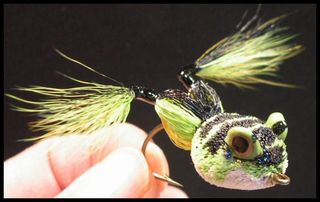 The centerpiece of the cover of Stewart and Allen's landmark book, "Flies for Bass and Panfish" is a photograph of several bucktail frogs. In the "Frog Patterns" section, four Messinger Frogs are featured - two versions by Joe Sr. and two versions by Joe Jr. In the "Insect Patterns" section Joe's Nitehummer, tied by Joe Jr., is also featured. Both Jack Ellis in his book "Bassin with a Flyrod" and William G. Tapply in his book "Bass Bug Fishing" discuss the Bucktail Frog and Joe's place in bass bug history. John Likakis in his book "Bass Bug Basics" says that the best and easiest way to make jointed legs on a bass bug is to use Joe Messinger's technique for making jointed legs on his Bucktail Frog. 
Joe, Jr. (2009) No one can write more eloquently about Joe Messinger than his son. Joe, Jr. wrote two excellent feature articles for American Angler Magazine in 1991.The May/June feature article, Simply Irrestible, gives the history and tying techniques for his dad's dry fly, the "Irresistible." The Irresistible is almost as famous as the Bucktail Frog. The July/August feature article, The Messinger Bucktail Frog, gives the history and tying instructions for his dad's masterpiece. Both articles are a "must read" and I urge you to take the time to read them.  If you would like to read the article, "The Messinger Bucktail Frog" published in the July/August 1991 issue of The American Angler and you have Adobe Reader, click on the link below.  If you would like to read the article, "Simply Irresistible," published in the May/June 1991 issue of the American Angler Magazine and you have Adobe Reader, click on the link below. 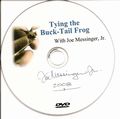 Several years ago Joe, Jr. produced a video of him tying the Bucktail Frog the way that his father tied it. He has since reproduced the video Tape on DVD. If you want to learn how to tie the Bucktail Frog the way that Joe's dad tied it you must have the DVD. If you are not a subscriber to American Angler or it's sister publication Fly Tyer, you should be. Both magazines are at the top of my list and I look forward to each issue. To learn more about these two great magazines click on the links below.
Tony Spezio Ties The Chili Pepper
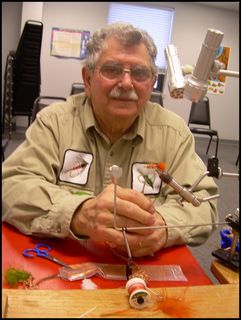 Anthony (Tony) Spezio is a professional fly tier and Bamboo Rod Maker from Flippin, Arkansas. He grew up in New Jersey where he learned to tie flies as a teenager. By the time he graduated from High School in 1948 he was teaching fly tying techniques in classes for fellow students at the school. During his working years in New Jersey Tony was a guest tier at many of the big eastern fly fishing shows. After retirement, he moved his family to Northwest Arkansas where he was able to fish for trout and smallmouth bass in the famous White River System and pursue his passion for fly tying and rod building on a full-time basis. There, he became a guest tier at the FFF Southern Council Conclave held each October in Mountain Home, Arkansas. Tony also became a guest fly tyer at other regional conclaves and fly fishing shows including the Federation of Fly Fishers International Conclave held each year in Montana. In 1997, with the help of his local fly fishing club, The North Aarkansas Fly Fishers, Tony was able to kick off a new fly tying event that became known as "The Sowbug Roundup". It started out as a small show in the community center in Cotter, Arkansas, on the banks of the White River, with 34 demonstration fly tiers and 225 attendees. Today the "Sow Bug Roundup" is better and bigger than ever. The three-day event held each March in Mountain Home, Arkasnas attracts hundreds of attendees each day. The centerpiece of the show features 170 demonstration tiers from the United States and Europe. Because of its success the Sow Bug Roundup has become nationally known as one of the premier fly fishing shows in the country. Over the years Tony has received many awards including the "Fly Tier of the Year" award from the Southern Council in 2007 and the Don Harger Memorial Award from the Federation of Fly Fishers in 2008. Tony also is a Pro Team Member for Gudebrod, Meg Eyes, Dyna King, and Conranch Hackle. Many of Tony's original fly designs have appeared in Fly Tying and Fishing Magazines, on internet web sites, in fly tying books, and on fly fishing television shows. One of his best know fly patterns is "Tony's Froggie" which is featured in one of two fly tying DVD'S offered by Tony. If you would like more information about the DVD'S go to Tony's web site Tuholer.com. 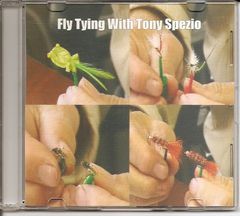
Volume I 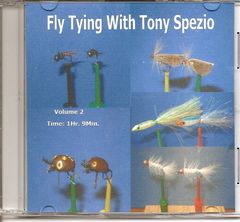
Volume II 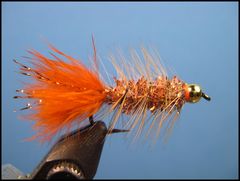 Another fly featured in his first DVD is called the Chili Pepper. This unique and easy fly to tie was created to catch trout but it has proven to be much more versitile than first expected. It's a great smallmouth bass fly and it has taken several species of fresh and saltwater fish. Tony will demonstrate how he ties the Chili Pepper in the tying sequence that follows. Join Tony as he describes the history of the Chili Pepper and as he takes you step by step through the tying process. This tribute was first published in the Winter 2008 issue of Fly Tyer Magazine as "Lacey Gee and His Gimp." If you are not a subscriber to Fly Tyer Magazine, you should be.
A Tribute to Lacey Gee and His Gimp
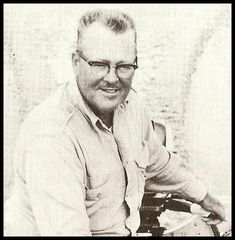 If I asked what you know about Lefty Kreh or Bob Clouser, you probably could tell me each man's contribution to fly-fishing without hesitation. On the other hand, if I asked what you know about Lacey Gee, your reaction probably would be, "Who?" That's understandable, but there's an interesting connection between these three fellows as you will see later. So, who was Lacey Gee? For starters, he was a fellow Iowan who lived in a state that is better known for its corn, soybean, and hog production than fly-fishing. Lacey learned to tie flies as a young man in the early 1920's. As an adult he became an accomplished fly fisherman, fly designer, professional fly tier, and fly fishing author. He also was an expert P-9 Combat Bi-Plane pilot with the Army Air Corps in the l930's and a trainer of Transport Glider pilots for the invasion of Europe during World War II. He loved golf, was a professional golfer for a time, and continued to play golf into his eighty's, consistently out-playing golfers half his age, even though he was burdened with a portable oxygen tank. But his real passion was fly tying and fishing. Among his many fly tying accomplishments, Lacey discovered that the marabou feather from the turkey we eat at Thanksgiving time was a great substitute for illegal African Stork marabou feaathers. His discovery resulted in the strung marabou that's found on almost every fly tier's desk today. However, in my opinion, his greatest accomplishment was founding the Wapsi Fly Company. 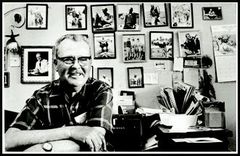 Lacey started the company in 1945 on the banks of the Wapsipinicon River in Independence, Iowa. After almost three decades the company had grown to become the third largest fly tying materials dealer in the country with Herters and Universal Vice in first and second place. By the time Lacey sold Wapsi to his friend Tom Schmuecker in 1973, the company was producing 15,000 flies weekly for several wholesale accounts with the remainder of the business coming from packaged fly tying materials and feathers. In 1978 Tom moved Wapsi Fly to Mountain Home, Arkansas, where it has become the largest wholesale distributor of fly tying materials in the world. Tom Schmuecker, by the way, invented lead barbell eyes. And that's the connection between Gee, Clouser, and Kreh. If Tom had not invented lead eyes, Bob Clouser wouldn't have created the Clouser Deep Minnow, and Lefty Kreh wouldn't have written that the Clouser Minnow is the best streamer he ever fished. 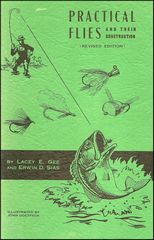 My introduction to Lacey Gee was through his book "Practical Flies and Their Constrution", published in 1955 with a revised edition in 1966. Lacey co-authored the book with his friend and fishing partner Erwin Sias, editor of the Sioux City Journal. According to Tom Schmuecker a copy of "Practical Flies and Their Construction" was included in thousands of fly tying kits sold by Wapsi, Universal Vice, Jann's Netcraft and others during that period. The little volume, no longer in print, contains only sixty-four pages, but it's packed with lots of relevant information and some great fishing tales. It also contains several interesting fly patterns. Many of them are Gee originals. One pattern, a nymph that Laced called the "Gimp", is particularly facinating. 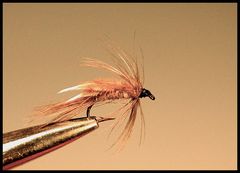 The photo on the right is an original Gimp tied by Lacey in the 1960"s and given to my friend Larry Myhre, the editor of Siouxland Outdoors and a fishing companion of both Lacey Gee and Tom Schmuecker. Gee wrote in "Practical Flies and Their Construction, that the Gimp was not a difficult fly to tie. The major problem, he said, was securing the proper feathers for the wing. He recommended using Amherst Pheasant tippets taken from an Amherst Pheasant neck. At the base of the tippet quill is a small feather laying parallel to the quill, and that feather is the secret of the Gimp, he wrote. 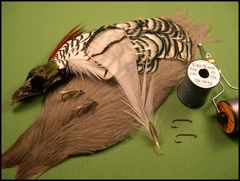 In addition to the aftershaft feather wing, other components of Gee's Gimp is a tail of naural dun hackle fibers, a gray wool body, and a couple of turns of dun hackle for a collar. Gee also instructed the tier to use natural duns if at all possible or, failing that, a dyed dun in the dark shade. The hackle for a wet fly should always come from a hen neck, Lacey wrote, because the fibers work better under water, being much softer than a rooster feather. The Gimp was so unique that in November 1950 Outdoor Life published a feature article written by Sias, titled, "They Go For the Gimp". And that was at a low time in our sport when outdoor magazines weren't devoting much ink to fly fishing or fly tying. Twenty years later in April 1970 Larry Myhre, a reporter at the Sioux City Journal and fishing companion of both Sias and Gee, published an article in the fledgling Fly Fisherman Magazine titled "Tying the Gimp Nymph". A few weeks after the article appeared Myhre received a call from Lacey telling him he had to stop production of all other flies to fill an order from a large fly fishing supplier for one-hundred forty dozen Gimps. In the decades that followed, Lacey's nymph fell into obscurity until 1993 when Dick Stewart and Farrow Allen reintroduced the Gimp to the fly tying community in their landmark pattern book, "Flies for Trout". The Sias article in Outdoor Life extolled the virtues of the Gimp when other flies weren't working on a trout fishing trip to the Long Pine Creek area in Nebraska's sand hills, but he said very little about the construction of the Gimp or how to fish it. Myhre's article in Fly Fisherman gave a much more detailed description of the Gimp and how to fish it. He suggested that lead wire was an option to help fish the Gimp in deeper water and that dubbing or peacock herl were good substitutes for the wool body that Lacey used. He also touted the little fly as a great bluegill and crappie lure. 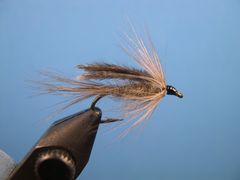 I like to tie my Gimps with a body made from Gray Squirrel dubbing instead of wool yarn to give the Gimp a buggier look. I often fish the Gimp as you would fish ordinary nymphs, but I relly prefer to fish it as a traditional wet fly, up and across stream with a wet fly swing. So, the next time you're on your favorite stream and the trout aren't interested in your offering, show them Lacey's little nymph. They just might "Go for the Gimp."
Warmwater Fly Tyer - by Ward Bean
© Copyright 2026 Ward Bean, Council Bluffs, IA, All rights reserved. © Copyright 2026 Ward Bean, Council Bluffs, IA, All rights reserved.
|
